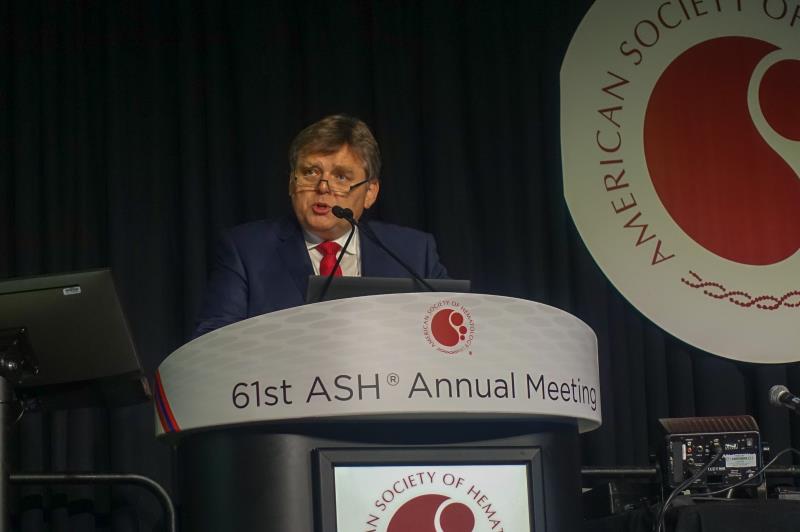 Dr Marek Trnĕný discussing the subgroup results of the AUGMENT trial.
Dr Marek Trnĕný discussing the subgroup results of the AUGMENT trial.The combination of the immunomodulatory agent lenalidomide and the monoclonal antibody rituximab (R2) proved effective and safe in individuals ≥70 years with relapsed/refractory indolent non-Hodgkin lymphoma (R/R iNHL) compared with rituximab alone, according to a post hoc analysis of the phase III AUGMENT* trial presented at ASH 2019.
“R2 has been approved by the US FDA** … based on the [initial] results and has received positive CHMP*** opinion for the treatment of adult patients with previously treated R/R iNHLs,” said study author Dr Marek Trnĕný from the Charles University Hospital in Prague, Czech Republic. “A subset analysis [showed that] patients ≥65 years benefited the same way from [R2 … As] advanced age is a very important risk/prognostic factor … [we sought to evaluate whether R2] is valid for the older population.”
Of the 358 patients with RR iNHL (follicular lymphoma [FL] and marginal zone lymphoma [MZL]) included in the trial, 91 were ≥70 years (median age 75 years). Participants were randomized 1:1 to receive R2 or R-placebo. Rituximab was administered at a dose of 375 mg/m2 on days 1, 8, 15, and 22 of cycle 1 and day 1 of cycles 2–5. Lenalidomide dose was 20 mg/day on days 1–21/28 for 12 cycles. [ASH 2019, abstract 347]
A trend for improved progression-free survival (PFS) was observed with R2 vs R-placebo (median, 24.9 vs 14.3 months; HR, 0.66, 95 percent confidence interval [CI], 0.37–1.18; p=0.158).
“[Although] this was not statistically significant, when we analysed the FL subset, there was a significant PFS improvement [with R2 vs R-placebo],” said Trnĕný, given the risk reduction of death or progression by 51 percent (median, 28.0 vs 14.3 months; HR, 0.49, 95 percent CI, 0.25–0.99; p=0.043).
The secondary endpoint of complete remission was higher with R2 vs R-placebo (26 percent vs 16 percent), which was consistent with the overall population (34 percent vs 18 percent).
There was also no difference between R2 and R-placebo in terms of time-to-next anti-lymphoma (TTNLT) treatment in the entire cohort (HR, 1.02, 95 percent CI, 0.50–2.09; p=0.959). In the FL subset however, a trend for prolonged TTNLT was observed (HR, 0.52, 95 percent CI, 0.20–1.31; p=0.156).
Safety-wise, grade 3/4 adverse events were mainly haematologic, the most common being neutropenia followed by leukopenia and anaemia, and mirrored those reported in the overall cohort.
“These data show that R2 maintained efficacy improvements vs R-placebo in [older iNHL] patients despite higher unfit status and lower overall lenalidomide treatment/exposure compared with the overall population,” said Trnĕný. “We can conclude that R2 is an effective and tolerable regimen … that can be used safely for [this patient subgroup].”
Although iNHL patients respond to standard-of-care chemotherapy, patients typically relapse or become refractory to treatment. [J Clin Oncol 2019;37:1188-1199] The consistent, favourable results across the overall and elderly subgroups of AUGMENT, coupled with the FDA nod, herald the R2 regimen as a potential new therapeutic alternative for R/R iNHL, said Trnĕný.
What about MZL?
Asked whether the results can be extrapolated to the MZL subgroup, Trnĕný noted that although they did analyse the effect of both regimens in this patient subset, there was no difference observed. “There was a low number of MZL patients or other indolent lymphomas within the study (n=25) … The major impact of R2 had been seen in the FL subset.”
While the US FDA approval covers all iNHLs, Trnĕný pointed out that given their findings, there might be alternatives for MZL apart from R2. “Rituximab monotherapy is definitely one of the options, but there might be some other options as well.”